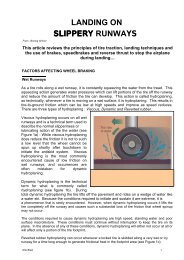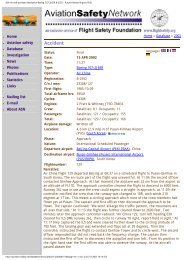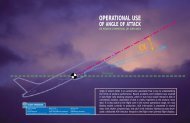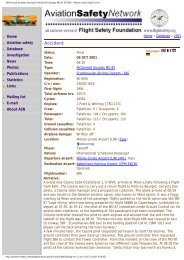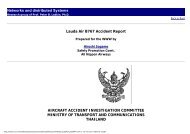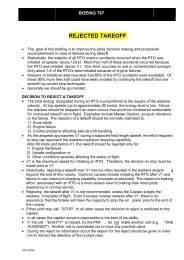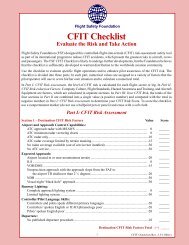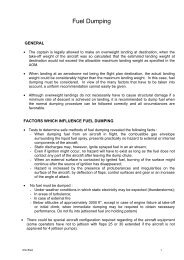Boeing 737-236 series 1, G-BGJL: Main document - Leonardo
Boeing 737-236 series 1, G-BGJL: Main document - Leonardo
Boeing 737-236 series 1, G-BGJL: Main document - Leonardo
You also want an ePaper? Increase the reach of your titles
YUMPU automatically turns print PDFs into web optimized ePapers that Google loves.
Visibility:<br />
Cloud:<br />
Temperature: + 13°C<br />
QNH:<br />
1,000 metres in smoke<br />
1 okta at 1,400 feet<br />
1015 millibars<br />
The Manchester Automatic Terminal Information Service (ATIS),information 'C' was received by<br />
the crew prior to starting engines.This gave the surface wind as 280°/6 kt, variable 240°-320°.When<br />
ATC cleared the aircraft for take-off, they passed a surfacewind of 250° at 7 kt. The runway was<br />
dry.<br />
1.8 Aids to navigation<br />
Not applicable.<br />
1.9 Communications<br />
1.9.1 ATC<br />
The RTF callsign of this flight was Beatours 28 Mike and VeryHigh Frequency (VHF)<br />
communications were entirely normal.<br />
Communications on the Ultra High Frequency (UHF) frequencies usedby the fire service and ATC,<br />
together with those on the telephonelinks, were normal.<br />
1.9.2 Aircraft public address (PA)<br />
The aircraft's PA system allowed announcements to the passengersto be made from the flight deck,<br />
the forward galley area, andthe rear galley area. The system had two gain (volume) levels,the lower<br />
for use before engine start, and the higher gain (by6 decibels) selected automatically by the<br />
operation of the leftengine oil pressure switch, for use after engine start and duringflight. The<br />
failure of the left engine therefore caused the systemgain to revert to the 'low' setting, significantly<br />
lowering thevolume at the time the purser instructed the passengers to remainseated and the<br />
commander ordered the evacuation A number of passengersdid not hear these announcements,<br />
however, whether this was dueto the lower volume or the effect of the noise level in the cabincould<br />
not be determined.<br />
1.9.3 Interphone system<br />
The aircraft's interphone system comprised a Service Interphone,allowing communication between<br />
the flight crew, cabin crew andground engineers, and a Flight Interphone to permit<br />
communicationbetween the flight crew and a ground crew member without interferencefrom the<br />
Service Interphone.<br />
It was possible to communicate with the flight deck from the forwardand rear cabin crew stations<br />
using the Service Interphone, butits use was not encouraged during periods of high flight<br />
crewworkload, such as take-off or landing, and it was not used followingthe 'thud'.<br />
1.10 Aerodrome information<br />
1.10.1 Manchester International Airport (Appendix 2)



